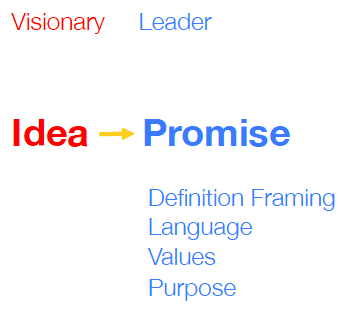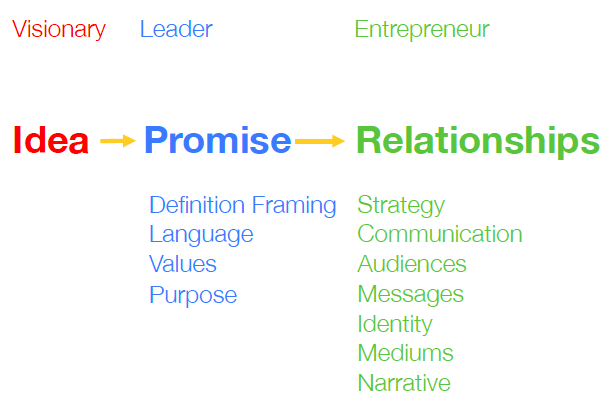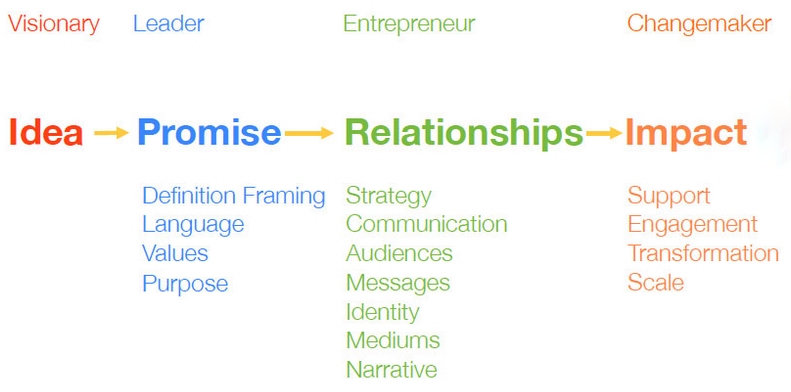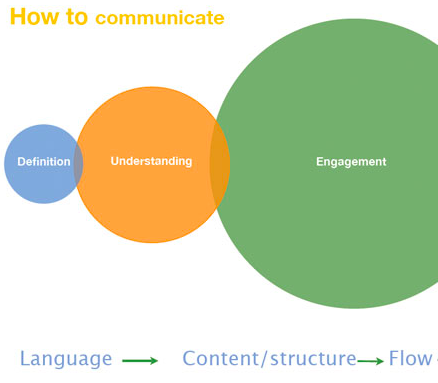For years now I have been giving workshops on how to design communication that has impact, changes minds, open eyes and hearts, shifts behavior. I’ve had many requests to share my slides and have attempted here to illustrate the process so it works without me. Hope it works for you.
First, here are a few core principles to communication design:
- Communication can solve 99 percent of the challenges we face if we simply learn not to suck at it. The ability to be heard and understood, to connect with people and engage them is a (or perhaps the) most important element in any relationship, and relationships are the beginning and the end of life.
- Communication—regardless of how big, complex or controversial—can be intentionally designed. It is not simply a talent that some have and others not so much.
- Communication is a system of interactions, beliefs, and messages that influence—and to a large extent—the “events”that we see and hear. And, that to create lasting impact, we need to work at a systems level.
- Like everything else that is meaningful, powerful communication begins deep inside us, with truths that are more than facts, more than intellect alone. Nothing meaningful can be spoken or understood unless it is felt. This is a dynamic to which people easily nod their heads, but struggle to live out, in our society’s disconnection from our bodies and series.
- It’s never too soon, or too late to get it right. Giant corporations, cities and governments have big, complex communication issues that can be aligned more easily than most believe—when they are approached as a system. And even the most inchoate entrepreneur should begin by designing the outcome at the start.
Whether you are a young social entrepreneur, a CEO, or simply a person who wants to move mountains and needs others to help you do it, these principles apply. Communication is the most important determinant of whether or not you will succeed in achieving your vision. Great leaders have it, there’s a way to do it.
Visionary to leader
You may have the most brilliant idea in the world, or a dozen of them, but unless you can explain them in a way that other people see their brilliance, you may be a visionary—you’ll remain a well-kept secret and will never be a leader.
Becoming a leader requires that you are able to express your vision in a way that people hear and respond to it. Most of the time, this has less to do with polish or vocabulary than it does with the power that comes from truth. To quote David Ogilvy:
Expressing an idea is something I have written quite a bit about before. The best way to do it is in the form of a promise. Writing a promise entails doing the hard work of determining what you truly want to accomplish, how you’re different, and what value you will provide to all those who support you.
Leader to entrepreneur
To be an entrepreneur means that you form an enterprise, or a business. One simple, powerful thing to keep in mind is that any business, regardless of how big or small, is nothing but a series of relationships—with team members, customers, funders, the media, suppliers, and so on. So it’s only when you understand how to use communication to intentionally create the right relationships with the right people (which you evaluate by communicating with them) that you can form an organization to realize your idea.
To develop relationships, you must understand your audiences, develop messages, create a narrative and an identity, and develop a strategy for the how, what, and where of communicating with them.
Entrepreneur to changemaker
Only when you can turn your relationships into action will you see real impact from your idea. What is it that moves people from passive agreement or low-risk and reward support to the kind of getting-off-their-butts-and-acting required to create change? You need to find out if you want to make a difference.
Real engagement requires mastery of communication—staying relevant and interesting to the people whose support you seek, providing value—through your communication, as well as your product or service, and staying in touch with the realities of their lives is crucial.
How to design effective communication
When you are creating communication in the service of an idea or mission, it’s useful to understand the different roles it plays, when to use them, and why the order is inviolate.
First, communication plays the role of defining the idea. (See visionary to leader). It is the what and why. It is also the core of the identity of your project or enterprise. Nothing can move forward successfully without this. If you have worked with large organizations, as I have, you will know that enormous money and time are devoted to initiatives that have not been fully defined in advance, and that they inevitably fail or limp along for years as a black hole of resources.
Next communication creates understanding. Think of it as the “kick-the-tires” phase. What kind of team is required, and who are they? How does it work, how much will it cost, how long will it take, and what is the strategy? This is where the structure of the enterprise is determined, where information is sought and disseminated to those who need it in order to make it real.
Communication can solve 99 percent of the challenges we face if we simply learn not to suck at it. Tweet This Quote
And finally, communication leads to engagement. This is the phase at which relationships are developed with a broader audience—all those for whom the enterprise will provide value. Here, a clear picture of the benefits, the role that products and services will play in people’s lives, what is expected of them in return, and how they can participate in it are brought to life. This is where emotion enters—where the hard work of understanding audience needs and context pays off, and where transformation takes place. C.S. Lewis states:
My challenge to you is to write down what you do, how you are unique in doing it, and why it matters. Then take out every single bit of jargon and do it again. Does it inform what you need to do in order to make it true? If not, do it again with more specificity.







